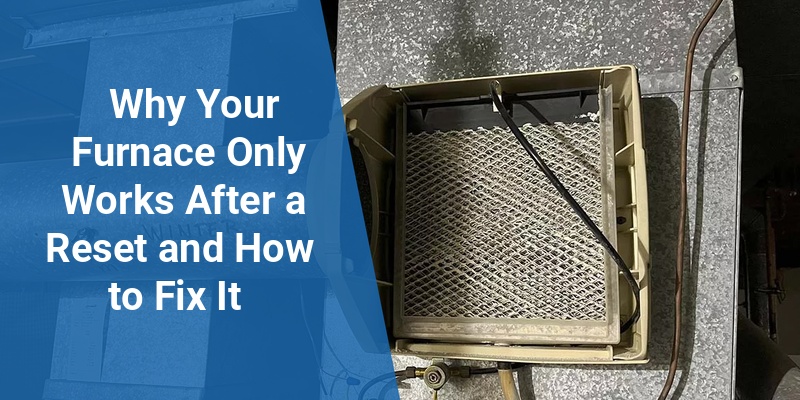When a furnace operates only after a reset, it signals an underlying issue that requires prompt attention. This common problem can disrupt home heating, especially during cold months, affecting comfort and safety. Understanding the reasons behind the furnace’s need for a reset helps homeowners diagnose and address the problem efficiently.
| Common Causes | Symptoms | Recommended Action |
|---|---|---|
| Dirty Flame Sensor | Furnace shuts down shortly after ignition | Clean or replace flame sensor |
| Faulty Limit Switch | Furnace overheats and cycles off | Inspect and replace limit switch |
| Blocked Airflow | Poor heating efficiency, frequent resets required | Replace filters, clear vents |
| Ignition Problems | Furnace fails to ignite until reset | Service ignition components |
| Electrical Issues | Intermittent power or sensor failures | Check wiring, sensors, or control board |
Common Reasons a Furnace Requires a Reset to Operate
Furnaces are complex appliances with multiple safety features designed to prevent hazards. When a furnace only works after resetting, it often means one of these safety mechanisms is repeatedly triggered. The flame sensor malfunction, limit switch issues, and airflow blockages rank as the top causes.
The flame sensor is a metal rod that detects whether the burner flame is lit. If it becomes dirty, it may not recognize the flame, causing the system to shut off as a safety measure. Resetting the furnace temporarily bypasses this, but the issue persists until cleaned.
Another typical culprit is the limit switch, which monitors internal furnace temperature. When overheated, it shuts the system down to prevent damage, requiring a reset after cooling. This can be triggered by restricted airflow caused by dirty filters or blocked vents.
Faulty ignition components like the pilot light or electronic ignitor can also cause the furnace to fail until a reset prompts a new ignition attempt. Lastly, electrical issues such as damaged wiring or control board errors can disrupt normal operation and necessitate resetting to restart the system.
Importance of Regular Furnace Maintenance
Routine maintenance plays a critical role in preventing furnace malfunctions that cause the need for resets. Annual inspection and cleaning by a qualified technician ensure the system runs efficiently and safely.
- Clean or Replace Filters: Dirty filters restrict airflow, causing overheating and frequent shutdowns.
- Clean Flame Sensor: Removing soot and debris prevents flame detection failure.
- Inspect Limit Switch and Ignition System: Early detection of wear or damage helps avoid shutdowns.
- Check Electrical Connections: Secure wiring prevents intermittent faults requiring resets.
Keeping the furnace components in good condition improves performance, reduces energy costs, and extends equipment lifespan.
Call 888-906-9139 for Free Local HVAC Quotes – No Obligation, Just Savings!
How to Diagnose and Fix a Furnace That Only Works After Resetting
For homeowners, identifying why the furnace needs resets starts with observing the symptoms and performing basic checks before calling a professional.
Step 1: Monitor Furnace Behavior
Note when the furnace shuts off and requires a reset. Is it shortly after startup, during a heating cycle, or sporadically? This information helps narrow down the issue.
Step 2: Inspect and Clean the Flame Sensor
Turn off power to the furnace, locate the flame sensor near the burner, and carefully wipe it with fine sandpaper or steel wool to remove buildup.
Step 3: Replace Air Filters and Clear Vents
Dirty filters and blocked vents reduce airflow causing overheating. Regularly replacing filters and ensuring vents are free improves safety and efficiency.
Step 4: Check Reset Button and Electrical Connections
Examine the reset button on the furnace control board for signs of wear or damage. Tighten any loose wiring connections visible and ensure power supply is steady.
Step 5: Call a Licensed HVAC Technician
If the furnace continues to shut off and only operates after resets despite basic maintenance, it’s advisable to seek professional diagnostic and repair services. Experts can test limit switches, control boards, and ignition systems with specialized tools.
Understanding Furnace Safety Features and Reset Functions
Modern furnaces contain multiple safety mechanisms to protect against fire, gas leaks, and equipment damage. Among these, the reset button functions as a manual override to restart the system after a safety shutdown.
Call 888-906-9139 for Free Local HVAC Quotes – No Obligation, Just Savings!
Common safety features include:
- Flame Sensor: Shuts off gas if flame is not detected to prevent gas buildup.
- Limit Switch: Prevents overheating by shutting the furnace down and requiring cool-down and reset.
- Pressure Switch: Ensures proper venting of combustion gases, shutting down if blocked.
The reset button temporarily bypasses a triggered safety mechanism, but frequent or repeated use indicates a malfunction that must be addressed professionally to avoid hazards.
When to Replace Your Furnace Instead of Repairing
Repeated resets and frequent breakdowns may suggest your furnace is approaching the end of its service life or suffers from costly issues beyond repair. Replacement should be considered if:
- The furnace is over 15-20 years old.
- Repairs cost more than 50% of a new system installation.
- Energy bills have risen significantly despite maintenance.
- System performance remains inconsistent after repairs.
Investing in a new high-efficiency furnace can provide better reliability, improved heating performance, and significant energy savings over time.
Energy Efficiency Considerations for Furnaces That Require Frequent Resets
A furnace that only operates after resets often runs inefficiently due to safety shutdowns caused by internal faults. These faults can increase fuel consumption and wear.
Energy efficiency improvements include:
- Regular Maintenance: Keeps components working optimally.
- Upgrading to a High-Efficiency Furnace: New models achieve efficiencies above 90%, reducing fuel use.
- Installing a Programmable Thermostat: Prevents unnecessary heating cycles and reduces strain.
- Sealing and Insulating Your Home: Decreases heat loss and workload for the furnace.
Addressing issues causing resets not only improves system reliability but also ensures better energy savings and lower utility bills.
Call 888-906-9139 for Free Local HVAC Quotes – No Obligation, Just Savings!
